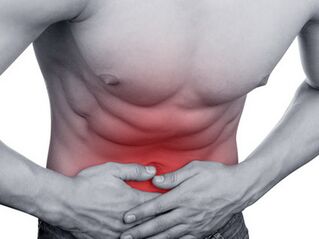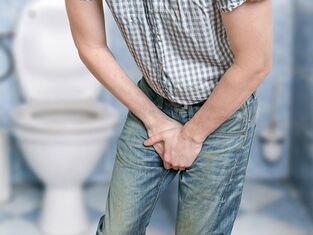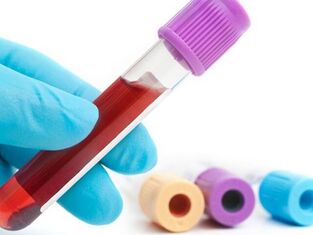Prostatitis refers to a purely male pathology of the urinary and reproductive system. The disease can be acute or chronic, and its manifestations are different in each patient. Today, it is a common disease of the genitourinary system. Currently, this disease is becoming much younger and has already occurred in men over 25 years of age. In this article, we will consider the following questions: how to manifest and treat prostatitis.

Required information
The nature of prostate dysfunction depends on a certain stage of male sexual development:
- May damage the prostate of underage men. However, due to the underdeveloped glands, this disease is not considered a separate disease.
- Men with difficult sex lives are more likely to develop prostatitis in the form of an acute inflammatory process; Prostate disease in adult men is manifested as one of the following three diseases: benign and malignant tumors, and chronic prostatitis.
People who have undergone any type of reproductive organ removal have no prostate function.
The prostate is an accessory gland of the genitalia in the strong half. It is located at the junction of the urinary tract and the ejaculation tunnel. Before puberty, the importance of the prostate in adolescent men has been ignored. In adults, the prostate is responsible for:
- The formation of secretions reduces the viscosity of semen and allows the sperm to survive the process of reaching the egg;
- Forms prostaglandins in the body. It is a component that causes increased blood flow to the genitals before erection. It also promotes the production of the hormone testosterone;
- Responsible for the high release rate of semen during ejaculation, and also participate in the appearance of the last moments of sexual intercourse related to the peak of intimate pleasure;
- With the help of reflexes, in intimate relationships, urine is not allowed to penetrate into semen.
The prostate is an organ that is not well protected by pathogenic microorganisms. It directly depends on the pathological condition of the pelvic organs. Large amounts of blood and lymph flow through the damaged prostate vessels, causing stagnation and edema, which intensifies inflammation. The gland contains a large number of nerve fibers, so the pathological manifestation is pain.

Prostatitis is inflammatory damage to the prostate. The most common cause of this disease is pelvic infection. However, the trapped infection cannot cause inflammation by itself; this requires the presence of predisposing factors. This category includes:
- The measured lifestyle (sedentary people are at risk);
- Keep stool regularly;
- Hypothermia;
- Overly active intimacy and long-term abstinence;
The prostate is a small organ, weighing about 20-25 grams. However, the secret of the gland has the ability to produce harmful effects on microorganisms. Therefore, inflammation of the prostate occurs during the stagnation period, and then the secret loses its bactericidal properties.
The manifestations of prostatitis
The disease is divided into two stages:
The acute form is the strongest inflammation of the prostate. The patient had a fever of 39 degrees, sore in the groin area, and excreted stool and urine. These are the first characteristic symptoms of prostatitis.
In chronic diseases, these symptoms have been relieved, so many men do not pay attention to the characteristic manifestations of the disease. The patient’s body temperature may rise to 37 degrees and may feel pain during urination and defecation. However, the main symptom of chronic prostatitis is the discharge of a small amount of mucus or purulent contents from the urethra.
Inducing factors
There are 6 initial symptoms of prostatitis-this is a failure in the urination process, because when the urethra is compressed by the enlarged prostate (dysuria syndrome), the urine excretion in the bladder leads to complicated urination function:
- Urine is excreted drop by drop;
- The painful feeling;
- The urine flow is pressureless and does not exceed 20 cm;
- Jet discontinuity;
- Often urinate at night;
- The feeling of incomplete bladder emptying.
Important! If these symptoms are found without a thorough examination, the diagnosis of prostatitis is prohibited. This disease has a very complex origin and development process, including various mechanisms.
Don't treat diseases based solely on clinical manifestations. You should contact an expert immediately for accurate diagnosis and prescription of treatment measures. Considering the organs and systems affected by the disease, diagnosis and treatment are recommended. In some cases, you need to consult other experts.
Signs of disease
Prostatitis can manifest as an acute form of the inflammatory process and is chronic. Acute diseases are characterized by inflammation of the mucosa, follicles and parenchyma, but they should not be confused with symptoms of prostate adenoma. And chronic-concomitant diseases.
Male prostatitis symptoms, through clinical and functional examination found:
- Frequent urination
Normal men have the urge to dehydrogenate up to 12 times (usually 5 times) a day. A healthy patient has 1 to 2 liters of urine per day. When the bladder is filled with 120-170 ml, there will be a desire to urinate for healthy men. The accumulation of more than 350 ml of urine produces the strongest urge to urinate.

In the course of inflammation, the bladder wall is systemically stimulated and urination becomes:
- is not uncommon, and urine output is within the normal range;
- A small amount: the products of the inflammatory process will stimulate the receptors of the bladder, and there is a false desire to peel off, a feeling of filling the bladder, and still maintaining a sense of fullness after emptying;
- Pain due to stricture of the urethra;
- Difficulty is due to glands oppressing the urethra, which sometimes manifests as the inability to empty the bladder when crowded;
- Go out often at night;
- Temperature.
Usually, the temperature rises from 37 degrees to 38 degrees. In the initial stage of purulent glands with purulent inflammation, the temperature rises more than 39 degrees. In contrast, in the final stage of septic shock, the temperature drops to 35 degrees. Due to platelet coagulation disorders, hypothermia is a threat to human life. The outcome of prostatitis with complications of sepsis is unfavorable.
- Urine
This is rare, but it is a red flag of disease progression. The constant bleeding is almost impossible to stop. There are many reasons for hematuria:
- , the blood vessel perforates into the urethra;
- trauma during the study;
- Malignant hyperplasia;
- Soreness.
Prostate inflammation accompanied by related complications is accompanied by constant pain. It is rarely intermittent. Usually, the pain is dull or sore and manifests in the perineum and anus.
Laboratory method
Used to identify the stage of the disease:
- Blood test. For the prostate, it was detected that the white blood cell content increased, the red blood cell sedimentation rate increased, and the white blood cell distribution direction stabilized cell movement;

- Urinalysis. Determine the purulent content and the presence of bacteria in the urine. The study used 3 jars: 3 servings of urine were taken at the beginning, middle and end of urination. A large number of urine studies conducted several days apart found that the bacterial flora has changed;
- Bacteriology blood culture. It is prescribed for the development of blood poisoning with daily temperature fluctuations between 3-5 degrees.
Tool Research
- Via rectal ultrasound. A clear diagnosis is the most useful method. The study has contraindications.
- X-ray method. Before the examination, a contrast agent is injected into the bladder.
Causes of prostatitis
Experts have identified several categories of prostatitis that a person may have:
- The symptoms of any disease that affects a person earlier or the negative effects of a partner’s gynecological disease;
- Urethral reflex. Prostate failure is full of failure to stop the return of urine. When this fluid reaches the reproductive tract, it is called urethral reflex. Subsequently, the bacteria that formed the glands were seeded. This disease is the result of an inflammatory process in the urethra or incorrect catheterization. The urethral lumen is also dilated.
- An unusual and private lifestyle. If a person’s number of sexual relationships increases or decreases significantly, it may lead to the development of prostatitis. The continued delay in ejaculation is also worrying;
- A plug for venous blood in the genitals in the pelvic area. This happens when there is not enough active movement, exercise; Hormonal imbalance caused by low levels of hormones formed in the gonads. Due to this pathology, skeletal and smooth muscle and other diseases are usually uncomfortable.

Types of prostatitis
This disease is divided into two parts: bacterial and non-bacterial.
< The first type of disease is characterized in that the disease is caused by the presence of pathogenic microorganisms that enter the human body from the external environment. Staphylococcus, streptococcus, E. coli and many other bacteria belong to the category of harmful microorganisms. In addition, this classification of prostatitis includes that the disease is caused by a sexually transmitted disease.For the second non-bacterial species, there are also the following divisions:
- Congestive prostatitis. In this case, adenopathy is caused by hyperemia in the pelvic area. This result is usually caused by incomplete ejaculation, excessive intimacy, long-term abstinence, and incomplete intercourse.
- Sclerosing prostatitis. It is characterized by a reduction in the size and function of the prostate. Due to the death of prostate cells and their degeneration into hard connective tissue, the tissue membrane thickens. The reasons for this type are bowel disorders, slow bowel movements, certain medications and a large number of infections, which are common bowel disorders. This type of prostate inflammation cannot be cured.
- Stone prostatitis. With this type of inflammation, stones are found in the glands. After reaching a larger size, they cause severe pain in the urethra. Treatment involves removing stones through surgery or treatment.
- Prostate pain. It is characterized by persistent pain in the pelvic area, the cause of which has not been studied. It is speculated that this may be caused by reflux of secretions, bladder neck disease, damage to the muscle tissue between the anus and reproductive organs, and psychological factors.
- Atypical prostatitis. The patient may complain of soreness in the lower limbs and lumbar bones, which is not present in typical prostatitis. The outcome of treatment is directly related to the duration of the disease, the presence of complications, and the severity of the inflammatory process.

If treatment is started at the wrong time, or prostatitis recurs, the inflammation will become severe and full of serious complications: decreased effectiveness, inability to have children, depression, severe pain, male prostateAdenoma.
Complications
Everything will directly depend on age, immunity, bad habits and the timeliness of treatment. Therefore, in the elderly with reduced immune systems, the consequences will be very serious due to excessive consumption of alcohol-containing products.
Actions on performance. Damaged glands reduce the production of hormones that cause erections. Complications include a lack of feeling of fullness during intimacy, poor drainage of semen, signs of male prostate adenoma, and yang.
The impact on the child's pregnancy. Inflammation of the prostate greatly reduces the production of normal secretions required for sperm activity in female genital fertilization. This secret entered the girl’s birth canal when she was intimate and was rejected by the immune system, resulting in the inability to fertilize the egg.
Other complications. As prostatitis worsens, the risk of pus accumulating in glandular tissues increases. Prostatitis pain worsens. After a secondary infection, the epithelium melts, and then a capsule appears near the inflammation. In addition, the consequences include retention of urine, urolithiasis, and acute attacks of prostate adenoma in men and others.
Intimacy with inflammation
It has been proven that the main cause of prostatitis is lack of sexual excitement or excessive sexual activity. Regular ejaculation at a normal frequency has a beneficial effect on the early stages of prostatitis. During certain procedures and stages of the disease, intimate contact is temporarily prohibited. For more detailed information, please consult an expert.
Important! During the treatment of prostatitis, you can have sex, but you can only maintain safety and moderation in your relationship, unless your doctor specifies otherwise.
Prostatitis is a purely male disease. However, inflammation of the glands poses a health risk to the partner. It poses a threat to the concept of the fetus and fertility. A healthy lifestyle and reliable contraceptive methods are effective ways to protect your partner from complications.

Prostatitis treatment
Only by timely referral to a specialist can you fully recover and stop the further development of the disease. In this case, you will get positive results. When there are irreversible changes, it is impossible to get rid of the disease completely. Usually, repeated inflammation will turn into a chronic form.
Together with medication, the important point is whether the patient is ready to change their lifestyle (for example, irregular close relationships or sedentary lifestyle). If the patient does not want to change his usual lifestyle, the disease will soon make himself feel himself again. It is precisely because patients do not want to change these negative factors, and the concept of incurable prostatitis is realized.
Processing options, after a complete inspection and determining the cause of the occurrence, the time period specified by the expertAntibiotics are the main drugs used during treatment. Vitamins, physical therapy, painkillers and anti-inflammatory drugs are also recommended. The worsening of prostatitis requires longer treatment time.
Diet
Through correct eating habits and the use of certain foods, you can achieve:
- Alleviate pain;
- Improve the movement of blood and lymph in the blood vessels of the prostate;
- Strengthen the immune system;
- Normalization of bowel function;
- Reduce urine production at night.
The following foods should be excluded from the diet:
- Coffee and spicy food-increase blood flow to the prostate and increase soreness.
- Fat, fatty meat, eggs, flour products-increase the formation of cholesterol plaques on blood vessel walls and reduce blood flow.
- Alcohol-containing products-lower the body's immune system.
- Crude fiber and salted food-destroy the ups and downs of the bowel wall.
- Too much fluid intake (especially at night)-increase the fluid content in the body, leading to puffiness.
Recommended food: fresh vegetable salad with olive oil, fruit, cooked lean meat, vegetables, juice and nuts.

Prevention
Recommended:
- Step length trail (physiological gait);
- Reasonable nutrition;
- Healthy lifestyle;
- Use male contraceptives;
- Moderate intimacy, etc.
Conclusion
There is no need to wait for the appearance of any disease, but for preventive purposes, it is necessary to see a doctor once a year. The treatment of exacerbation of secondary prostatitis is much more difficult, takes longer, and is full of its own complications.
In this article, we learned how the inflammation of the prostate is manifested, as well as the pain caused by prostatitis and how to treat this disease.
























